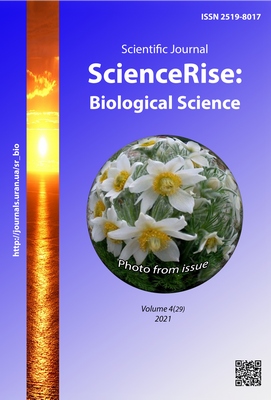Study of the efficiency of using biogenic metals for feeding calves
DOI:
https://doi.org/10.15587/2519-8025.2021.249859Keywords:
calves, biogenic metal nicotinates, inorganic substances, blood biochemical parametersAbstract
Breeding young cattle is important, especially during the transition period from dairy feeding to concentrated dry feed. The paper presents the results of the use of biogenic metal nicotinates for weaning calves to improve metabolism in animals.
The aim of research. To investigate the effect of biogenic metal nicotinates: Zn, Cu, Fe, Co, Mn on the biochemical parameters of blood in calves after weaning.
Materials and methods. The study was carried out during 2021 in the conditions of LLC "Agrofirma Lan", Sumy region, Sumy district, Kindrativka, Ukraine for breeding young cattle. The calves of the experimental group were given compound feed and a premix of nicotinates of biogenic metals: Zn, Cu, Fe, Co, Mn, manufactured by PPronos Agro" (1 g per 1 kg of feed). In the control group, combined feed and a premix with metal sulfates were used for 30 days.
Results. An increase in the level of total protein in the body of calves of the experimental groups was established by 16.12 % in comparison with the control (p≤0.05). Also, in experimental animals, the activity of the enzymes alanine aminotransferase and aspartate aminotransferase was higher than the physiological norm, which shows an insignificant effect of nicotinates of biogenic metals on internal organs and systems. In the experimental group of calves, the level of magnesium was probably higher by 52.38 % and potassium – by 14.94 % compared to the control group (p≤0.05). It was found that the animals of the experimental groups probably had more zinc by 34.96 %; copper – by 35.72 %; iron – by 92.29 %; manganese – by 41.13 %; selenium – by 3.22 % and cobalt – by 98.33 % compared to the control (p≤0.05).
Conclusions. The positive effect of the use of biogenic metal nicotinates on the metabolism of calves at weaning has been proven. It was found that the level of total protein in the body of calves of the experimental groups was probably higher by 16.12 %, magnesium - by 52.38 %; potassium - by 14.94 %. When determining the content of inorganic substances, it was found that the animals of the experimental groups probably had more zinc by 34.96 %; copper – by 35.72 %; iron – by 92.29 %; manganese – by 41.13 %; selenium – by 3.22 % and cobalt – by 98.33 % compared to the control (p≤0.05)
References
- Shkromada, O., Dudchenko, Y., Udovenko, Y. (2021). Use of probiotics for formation of microflora of gastrointestinal tract of calves. EUREKA: Health Sciences, 4, 94–100. doi: http://doi.org/10.21303/2504-5679.2021.001951
- Erickson, P. S., Kalscheur, K. F. (2020). Nutrition and feeding of dairy cattle. Animal Agriculture. Elsevier Inc., 157–180. doi: http://doi.org/10.1016/b978-0-12-817052-6.00009-4
- Davis Rincker, L. E., VandeHaar, M. J., Wolf, C. A., Liesman, J. S., Chapin, L. T., Weber Nielsen, M. S. (2011). Effect of intensified feeding of heifer calves on growth, pubertal age, calving age, milk yield, and economics. Journal of Dairy Science, 94 (7), 3554–3567. doi: http://doi.org/10.3168/jds.2010-3923
- Van Amburgh, M. E., Soberon, F., Meyer, M. J., Molano, R. A. (2019). Integration of postweaning nutrient requirements and supply with composition of growth and mammary development in modern dairy heifers. Journal of Dairy Science, 102 (4), 3692–3705. doi: http://doi.org/10.3168/jds.2018-15270
- Ding, J., Shi, M., Wang, L., Qi, D., Tao, Z., Hayat, M. A. et. al. (2020). Gene Expression of Metalloproteinases and Endogenous Inhibitors in the Lamellae of Dairy Heifers With Oligofructose-Induced Laminitis. Frontiers in Veterinary Science, 7. doi: http://doi.org/10.3389/fvets.2020.597827
- Fotina, T., Fotina, H., Nazarenko, S., Tymoshenko, R., Fotin, O. (2021). Effect of feeding of chelated zinc form on security, productivity and slaughter parameters of broilers. EUREKA: Health Sciences, 3, 110–118. doi: http://doi.org/10.21303/2504-5679.2021.001856
- Tomlinson, D. J., Mülling, C. H., Fakler, T. M. (2004). Invited Review: Formation of Keratins in the Bovine Claw: Roles of Hormones, Minerals, and Vitamins in Functional Claw Integrity. Journal of Dairy Science, 87 (4), 797–809. doi: http://doi.org/10.3168/jds.s0022-0302(04)73223-3
- Varagka, N., Lisgara, M., Skampardonis, V., Psychas, V., Leontides, L. (2016). Partial substitution, with their chelated complexes, of the inorganic zinc, copper and manganese in sow diets reduced the laminitic lesions in the claws and improved the morphometric characteristics of the hoof horn of sows from three Greek herds. Porcine Health Management, 2 (1). doi: http://doi.org/10.1186/s40813-016-0040-3
- Vlizlo, V. V. (2012) Laboratorni metody doslidzhen u biolohii, tvarynnytstvi ta veterynarnii medytsyni. Lviv: SPOLOM, 764.
- Miles, R. D., Henry, P. R. (2006). Relative trace mineral bioavailability. Ciência Animal Brasileira, 1 (2), 73–93. Available at: https://www.revistas.ufg.br/vet/article/view/252
- Mantovani, A. (2017). Safety and efficacy of zinc chelate of methionine sulfate for all animal species. EFSA journal. European Food Safety Authority, 15 (6). doi: http://doi.org/10.2903/j.efsa.2017.4859
- Andrieu, S. (2008). Is there a role for organic trace element supplements in transition cow health? The Veterinary Journal, 176 (1), 77–83. doi: http://doi.org/10.1016/j.tvjl.2007.12.022
Downloads
Published
How to Cite
Issue
Section
License
Copyright (c) 2021 Oksana Shkromada, Tatiana Fotina, Roman Petrov

This work is licensed under a Creative Commons Attribution 4.0 International License.
Our journal abides by the Creative Commons CC BY copyright rights and permissions for open access journals.
Authors, who are published in this journal, agree to the following conditions:
1. The authors reserve the right to authorship of the work and pass the first publication right of this work to the journal under the terms of a Creative Commons CC BY, which allows others to freely distribute the published research with the obligatory reference to the authors of the original work and the first publication of the work in this journal.
2. The authors have the right to conclude separate supplement agreements that relate to non-exclusive work distribution in the form in which it has been published by the journal (for example, to upload the work to the online storage of the journal or publish it as part of a monograph), provided that the reference to the first publication of the work in this journal is included.









